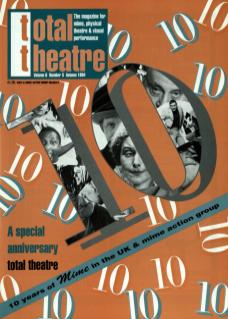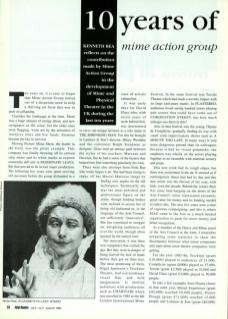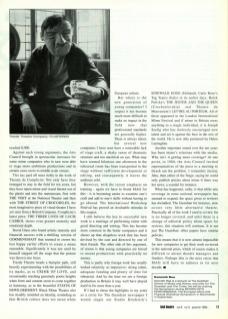Ten years on, it is easy to forget that Mime Action Group started out of a desperate need to help a thriving art form that was in peril of collapsing. Consider the landscape at the time. There was a huge amount of energy about, and new companies on the scene, but the older ones were flagging, worn out by the pressures of intensive tours and low funds. Stamina became the key to survival.
Moving Picture Mime Show, the leader in the field, was the prime example. This company was finally throwing off its cartoon strip mime and its white masks to explore commedia dell'arte in Passionate Leave. But that proved to be its last major production. The following few years were spent reviving old successes before the group disbanded in a state of artistic exhaustion.
It was early days for David Glass who, with seven years of work behind him, was determined to carve out unique territory as a solo mime in The Shrinking Man. For this he brought in Lumiere & Son's director, Hilary Westlake, and the cartoonist Ralph Steadman as designer. Glass trod an uneasy path between the styles of his teachers, Marceau and Decroux, but he had a sense of the bizarre that helped him find something genuinely his own.
There were also stirrings from Nola Rae who really began it all. She had been trying to shake off her Marcel Marceau image by finding new angles on the old techniques. Technically she was the most polished and professional figure on the scene, though funding bodies were inclined to accuse her of being old fashioned or, in the language of the Arts Council, not sufficiently ‘innovative’. She has continued to struggle on, delighting audiences all over the world, though often ignored by the radical core.
For innovation, it was three new companies that carried the day. But they were in danger of being starved for lack of funds before they got on their feet. The most promising of them, Nigel Jamieson's Trickster Theatre, had extraordinary visual flair and bold imagination. It thrilled audiences with productions such as Charivari which was unveiled in 1985 at the 8th London International Mime Festival. In the same festival was Trestle Theatre which had made a novelty impact with its large caricature masks. In Plastered, audiences loved seeing masked actors playing pub scenes that could have come out of Coronation Street, but how much mileage was there in this?
Also in that festival was the young Theatre de Complicite, gradually finding its way with small scale improvisatory shows such as A Minute Too Late. In many ways it trod more dangerous ground than its colleagues because it had no visual gimmicks: the emphasis was wholly on the actors playing together as an ensemble with minimal scenery and props.
This new work had its rough edges, but there was excitement in the air. It seemed as if contemporary dance had had its day and this new mime was the flavour of the year, with luck, even the decade. Behind the scenes there was some loud banging on the doors of the Arts Council: mime represented extremely good value for money and its funding needed to reflect this. The next few years were a time of vigorous campaigning, and this is where MAG came to the fore as a much needed organisation to push for more money and better recognition
As a member of the Dance and Mime panel of the Arts Council at the time, I remember preparing some statistics to show the discrepancy between what mime companies and equivalent sized theatre companies were getting.
For the year 1985-86, Trickster (grant £10,000) played to audiences of 21,000. Complicite (grant £8000) played to 37,000, Trestle (grant £2500) played to 23,000, and David Glass (grant £3000) played to 50,000 people.
To take a few examples from Drama clients in that same year, Shared Experience (grant £92,000) reached 10,000 people, Paines Plough (grant £71,000) reached 12,000 people, and Lumiere & Son (grant £65,000) reached 8000.
Against such strong arguments, the Arts Council brought in spectacular increases for some mime companies who in turn were able to stage more ambitious productions and in certain cases move to middle scale venues.
This has paid off most richly in the work of Theatre de Complicite. Not only have they managed to stay in the field for ten years, but they have taken mime and visual theatre out of the ghetto and into the mainstream, first with The Visit at the National Theatre and then with The Street of Crocodiles, the most imaginative piece of visual theatre I have yet seen from a British company. Complicite's latest piece, The Three Lives of Lucie Cabrol shows even greater maturity and emotional depth.
David Glass also found artistic maturity and financial success with a thrilling version of Gormenghast that seemed to crown his less happy earlier efforts to create a mime ensemble. Significantly it was not until he himself stepped off the stage that the picture was thrown into focus.
Trestle Theatre treads a bumpier path, still bravely experimenting with the possibilities of its masks, as in Crime of Love, and occasionally reaching genuinely poetic heights when form and content seem to come together in harmony, as in the beautiful States of Bewilderment. Black Mime Theatre also has steadily moulded an identity, reminding us that British culture does not mean white European culture.
But where is the new generation of young companies? I suspect it has become much more difficult to make an impact in the field now that professional standards are generally higher. There is always talent, but several new companies I have seen have a noticeable lack of stage craft, a shaky sense of dramatic structure, and too uncritical an eye. What may have seemed hilarious one afternoon in the rehearsal room has been transported to the stage without sufficient development or editing, and consequently it leaves the audience cold.
However, with the recent emphasis on training – again we have to thank MAG for this – it is becoming easier to examine one's craft and add to one's skills without having to go abroad. The International Workshop Festival has proved an invaluable stimulus in this respect.
I still believe the key to successful new work is a marriage of performing talent with good directing and writing. This has become more common in the better companies and it shows up that shapeless work that has been devised by the cast and directed by one of their friends. The other side of this argument, of course, is that young companies are forced to mount productions with practically no money.
This is partly why foreign work has usually looked relatively so impressive: strong talent, adequate funding, and plenty of time for rehearsal. And by the time we see a foreign production in Britain it may well have played itself in for more than a year.
If I had to chose the highlights in my years as a critic for The Guardian newspaper I would single out Studio Hinderick's Sidewalk Edge (Holland), Carlo Boso's Tag Teatro (Italy) in its earlier days, Bolek Polivka's The Jester and the Queen (Czechoslovakia) and Theatre du Mouvement's Lettre au Porteur. All of these appeared in the London International Mime Festival and if mime in Britain owes anything to a single individual, it is Joseph Seelig who has tirelessly encouraged new talent and set it against the best in the rest of the world. He is now ably partnered by Helen Lannaghan.
Another important strand over the ten years has been mime's relations with the media. Why isn't it getting more coverage? At one point, in 1988, the Arts Council invited representatives of the press to a meeting to thrash out the problem. I remember Jeremy Jehu, then editor of The Stage, saying he could only publish articles about mime if there was hot news, a scandal for instance.
What has happened, sadly, is that while arts coverage in some national newspapers has seemed to expand, the space given to reviews has dwindled. The Guardian, for instance, now covers very little alternative theatre. Practically all of the work I used to review is no longer covered, and until there is a change of editorial policy about space for reviews, this situation will continue. It is not just The Guardian: other papers have similar policies.
This means that it is now almost impossible for new companies to get their work reviewed in the national press, which of course makes it difficult to attract theatre managers and funders. Perhaps this is the next crisis that MAG will have to address in its next decade.
Kenneth Rea Kenneth Rea is a lecturer at The Guildhall School of Music and Drama, and critic for The Guardian and The Times. He will be chairing the Symposium during Moving Into Performance, The European Mime and Physical Workshop Symposium in Manchester in September.


